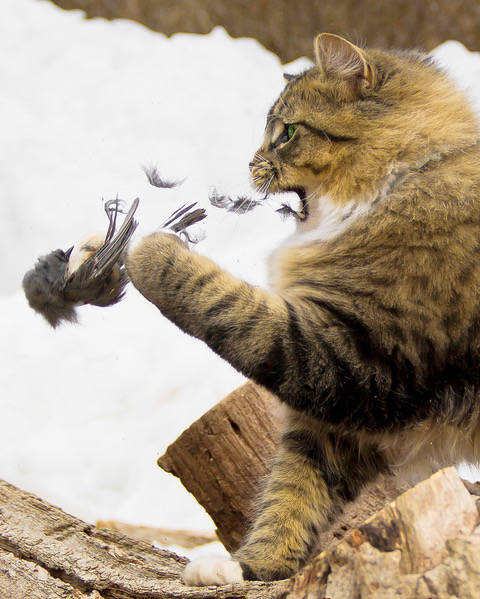Birds lead a busy and precarious life. When they aren’t spending their time and energy in search of food, building a nest, defending their territories, breeding, raising their young, sleeping, migrating, and searching for suitable wintering and breeding habitat, they are trying to avoid becoming another bird or animal’s next meal.
One of the main threats to birds are feral and domestic cats.
Outdoor cats play a significant role as predators of birds and other small animals.
A research study published in 2013 estimates that each year between 1.3 and 4.0 billion (yes that’s billion) birds are killed by domestic and feral cats in the United States.
Hard to imagine, but true.
You may think “not my precious kitty,” but every outdoor cat is a natural and effective predator and has killed at least one bird.
Domestic rural cats kill more wildlife animals per year than urban cats — an estimated 14 wild animals per year. This is a significant number. We live in a rural community.
Many pet owners who no longer want their pets dump them outdoors, rather than take them to animal shelters where they have a chance of being adopted.
A stray cat, if not spayed or neutered, produces a prodigious number of offspring.
These offspring — feral cats — are estimated to be around 70 million (and growing) in the United States alone.
That is a lot of unwanted, hungry cats. And the population of domestic (pet) cats in the United States is estimated to be around 95 million.
In 2017, the Alaska Board of Game received a proposal to allow sterilized feral cats to be released into the wild. Feral cats are one of a number of animals on a list of species prohibited from being released due to damage they are known to cause when released.
In November 2017, the Alaska Board of Game voted unanimously to reject the proposal and thereby keeping feral cats on the no-release list, even those who have been sterilized.
The Board of Game was concerned about disease and predation of birds and small animals by feral cats.
For the health of your cat and the health of birds, be a responsible cat owner. Leave your cat(s) indoors.
Cats that spend time outdoors have shorter life spans than those cats that live their entire lives indoors. An outdoor cat has an estimated life span of 1 to 5 years, while your indoor cat can live up to 15 years.
Outdoor cats are susceptible to disease, starvation, hypothermia, and predation — they too can be killed and eaten by wildlife such as dogs, coyotes and eagles.
They can also be killed by vehicles. Protect our birds, and protect your cats — please keep Fluffy indoors.
Spay or neuter you cats. Do not dump unwanted cats; bring them to a local animal shelter. Resist feeding feral cats, unless you are trying to capture one to bring to a shelter.
Despite the fact feral cats may be neutered or even declawed, they are still effective predators and can still wreak havoc on small animal and bird populations.
For more information about the dangers cats pose and the dangers they face, check out the American Bird Conservancy’s website at: www.abcbirds.org.
This article is brought to you by the Kachemak Bay Birders. For more information about Kachemak Bay Birders birding trips, meetings, and other activities and events, go to kachemakbaybirders.org. Check out also the Bird of the Month, Citizen Science opportunities, Local Bird Information and much more. It’s a Great Day to Bird!


